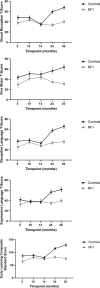Developmental trajectories in infants and pre-school children with Neurofibromatosis 1
- PMID: 39407332
- PMCID: PMC11481376
- DOI: 10.1186/s13229-024-00621-5
Developmental trajectories in infants and pre-school children with Neurofibromatosis 1
Abstract
Background: Children with Neurofibromatosis 1 (NF1) show cognitive, behavioural and social differences compared to their peers. However, the age and sequence at which these differences begin to emerge is not fully understood. This prospective cohort study examines the cognitive, behavioural, ADHD trait and autism symptom development in infant and pre-school children with NF1 compared with typically developing (TD) children without a family history of neurodevelopmental conditions.
Methods: Data from standardised tests was gathered at 5, 10, 14, 24 and 36 months of age (NF1 n = 35, TD n = 29). Developmental trajectories of cognitive (Mullen Scales of Early Learning, MSEL) and adaptive behavioural (Vineland Adaptive Behavior Scales, VABS) development from 5 to 36 months were analysed using linear mixed modelling. Measures of ADHD (Child Behavior Checklist) and autism traits (ADOS-2, BOSA-MV and ADI-R) were assessed at 24 and 36 months.
Results: The developmental trajectory of cognitive skills (all domains of the MSEL) and behavioural skills (four domains of the VABS) differed significantly between NF1 and TD groups. Post-hoc tests demonstrated that the NF1 participants scored significantly lower than TD participants at 24 months on all MSEL and VABS domains. The NF1 cohort demonstrated higher mean autism and ADHD traits at 24 months and 14% of the NF1 cohort met a research diagnostic classification for autism at 36 months.
Limitations: The study has a relatively small sample size due to variable retention and rolling recruitment. Due to limitations imposed by the COVID-19 pandemic, we utilised the Brief Observation of Symptoms of Autism for Minimally Verbal children (BOSA-MV) for some participants, which was administered online and may not gather as accurate a picture of traits as ADOS-2. The BOSA-MV was utilised for 41% of participants with NF1 at 36 months compared to 11% at 24 months. This may explain the reduction in the percentage of children with NF1 that met autism criteria at 36 months.
Conclusions: By 24 months of age, the NF1 cohort show lower cognitive skills and adaptive behaviour and higher levels of autism and ADHD traits as compared to TD children. This has implications for developmental monitoring and referral for early interventions.
Trial registration: Not applicable.
Keywords: ADHD; Autism; Children; Cohort; NF1; Neurofibromatosis; Trajectories.
© 2024. The Author(s).
Conflict of interest statement
TC has served as a paid consultant to F. Hoffmann-La Roche Ltd. and Servier; and has received royalties from Sage Publications and Guilford Publications. The other authors have no conflicts of interest to disclose.
Figures




References
-
- Evans DG, Howard E, Giblin C, Clancy T, Spencer H, Huson SM, et al. Birth incidence and prevalence of tumor-prone syndromes: estimates from a UK family genetic register service. Am J Med Genet A. 2010;152A(2):327–32. 10.1002/ajmg.a.33139. - PubMed
-
- Brei NG, Klein-Tasman BP, Schwarz GN, Casnar CL. Language in young children with neurofibromatosis-1: relations to functional communication, attention, and social functioning. Res Dev Disabil. 2014;35(10):2495–504. 10.1016/j.ridd.2014.06.016. - PubMed
-
- Hyman SL, Shores A, North KN. The nature and frequency of cognitive deficits in children with neurofibromatosis type 1. Neurology. 2005;65(7):1037–44. 10.1212/01.wnl.0000179303.72345.ce. - PubMed
Publication types
MeSH terms
LinkOut - more resources
Full Text Sources
Research Materials
Miscellaneous

